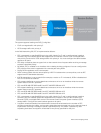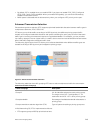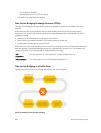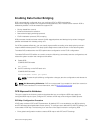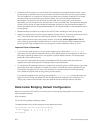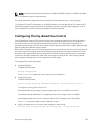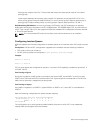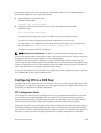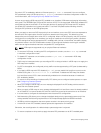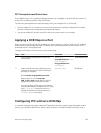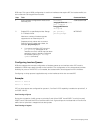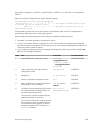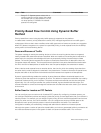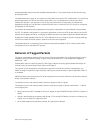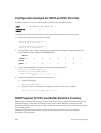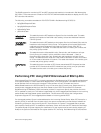
On switch, PFC is enabled by default on Ethernet ports (pfc mode on command). You can configure
PFC parameters using a DCB map or the pfc priority command in Interface configuration mode. For
more information, see
Configuring Priority-Based Flow Control.
As soon as you apply a DCB map with PFC enabled on an interface, DCBx starts exchanging information
with a peer. The IEEE802.1Qbb, CEE and CIN versions of PFC TLV are supported. DCBx also validates PFC
configurations that are received in TLVs from peer devices. By applying a DCB map with PFC enabled,
you enable PFC operations on ingress port traffic. To achieve complete lossless handling of traffic,
configure PFC priorities on all DCB egress ports.
When you apply or remove a DCB input policy from an interface, one or two CRC errors are expected to
be noticed on the ingress ports for each removal or attachment of the policy. This behavior occurs
because the port is brought down when PFC is configured. When a DCB input policy with PFC profile is
configured or unconfigured on an interface or a range of interfaces not receiving any traffic, interfaces
with PFC settings that receive appropriate PFC-enabled traffic (unicast, mixed-frame-size traffic) display
incremental values in the CRC and discards counters. (These ingress interfaces receiving pfc-enabled
traffic have an egress interface that has a compatible PFC configuration).
NOTE: DCB maps are supported only on physical Ethernet interfaces.
• To remove a DCB map, including the PFC configuration it contains, use the no dcb map command
in Interface configuration mode.
• To disable PFC operation on an interface, use the no pfc mode on command in DCB-Map
configuration mode.
• Traffic may be interrupted when you reconfigure PFC no-drop priorities in a DCB map or re-apply the
DCB map to an interface.
• For PFC to be applied, the configured priority traffic must be supported by a PFC peer (as detected by
DCBx).
• If you apply a DCB map with PFC disabled (pfc off), you can enable link-level flow control on the
interface using the flowcontrol rx on tx on command. To delete the DCB map, first disable
link-level flow control. PFC is then automatically enabled on the interface because an interface is
PFC-enabled by default.
• To ensure no-drop handling of lossless traffic, PFC allows you to configure lossless queues on a port
(see Configuring Lossless Queues).
• When you configure a DCB map, an error message is displayed if the PFC dot1p priorities result in
more than two lossless queues.
• When you apply a DCB map, an error message is displayed if link-level flow control is already enabled
on an interface. You cannot enable PFC and link-level flow control at the same time on an interface.
• In a switch stack, configure all stacked ports with the same PFC configuration.
• Dell Networking OS allows you to change the default dot1p priority-queue assignments only if the
change satisfies the following requirements in DCB maps already applied to S6000 interfaces:
• All 802.1p priorities mapped to the same queue must be in the same priority group.
• A maximum of two PFC-enabled, lossless queues are supported on an interface.
Otherwise, the reconfiguration of a default dot1p-queue assignment is rejected.
• To ensure complete no-drop service, apply the same PFC parameters on all PFC-enabled peers.
256
Data Center Bridging (DCB)



